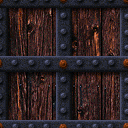Using Cinema 4D to Create Game Textures
- jimht3
- May 19, 2020
- 2 min read
I am in the process of re-doing all of the textures for the Marathon Infinity scenario Tempus Irae. Here's a quick YouTube preview of one of the levels:
As I did in 2006 for the 10th anniversary upgrade of the game for the Aleph One engine, I am re-doing the textures in Cinema 4D. There are two reasons for this:
1) Aleph One and modern computers and graphics cards allow for larger texture sizes. The original game had textures that were 128 x 128 in size.
From left to right, 1996, 2006, 2020
In 2006 we doubled that to 256 x 256 to achieve even greater visual fidelity. In this final 'remix' version, I've doubled it again to 512 x 512, with the occasional texture going up to 1024 x 1024.
2) In addition to texture sizes, the current version of Aleph One allows for 'parallax' textures - textures that appear to have depth when viewed from the side. This greatly adds to the feeling of realism in a 25 year old game that was roughly on the same technical level as DOOM and other sector based 2.5 D engines. You can see the effect in the video clip above. This effect is achieved through the use of a specially formulated texture that combines a 'normal' map of the surface (each pixel encodes what direction it is facing in 3 colour channels of an image - green is up to down, red is right to left, and blue is back to front) and a depth map of the surface - white is closest to viewer, black is furthest. The result:

In the game engine, the effect can be quite astonishing. I'm not the first person to utilize this ability of Aleph One (I fact, I might be quite late to the party on this one) but my method of creating the textures may be somewhat unique. The 1996 textures were largely constructed in Photoshop - they are essentially drawings. The 2006 textures were largely created in 3D in Cinema 4D, but no attempt was made to create a cohesive three dimensional model - If something needed to be in the foreground of a texture, I would just push it closer to the 'camera' because there was no way to tell what the actual dimensional quality of the texture really was. In these 2020 textures I have had to take the groundwork I laid in 2006, and rework every texture so that it makes sense in three dimensional space. The result is that I get correct surface normals and correct depth for the parallax effect to work.
I am also taking this opportunity to polish up some of the sculpture and artwork used in the game (using Da Vinci's master Verocchio's work in some places).
More to come as I get more completed.






Comments